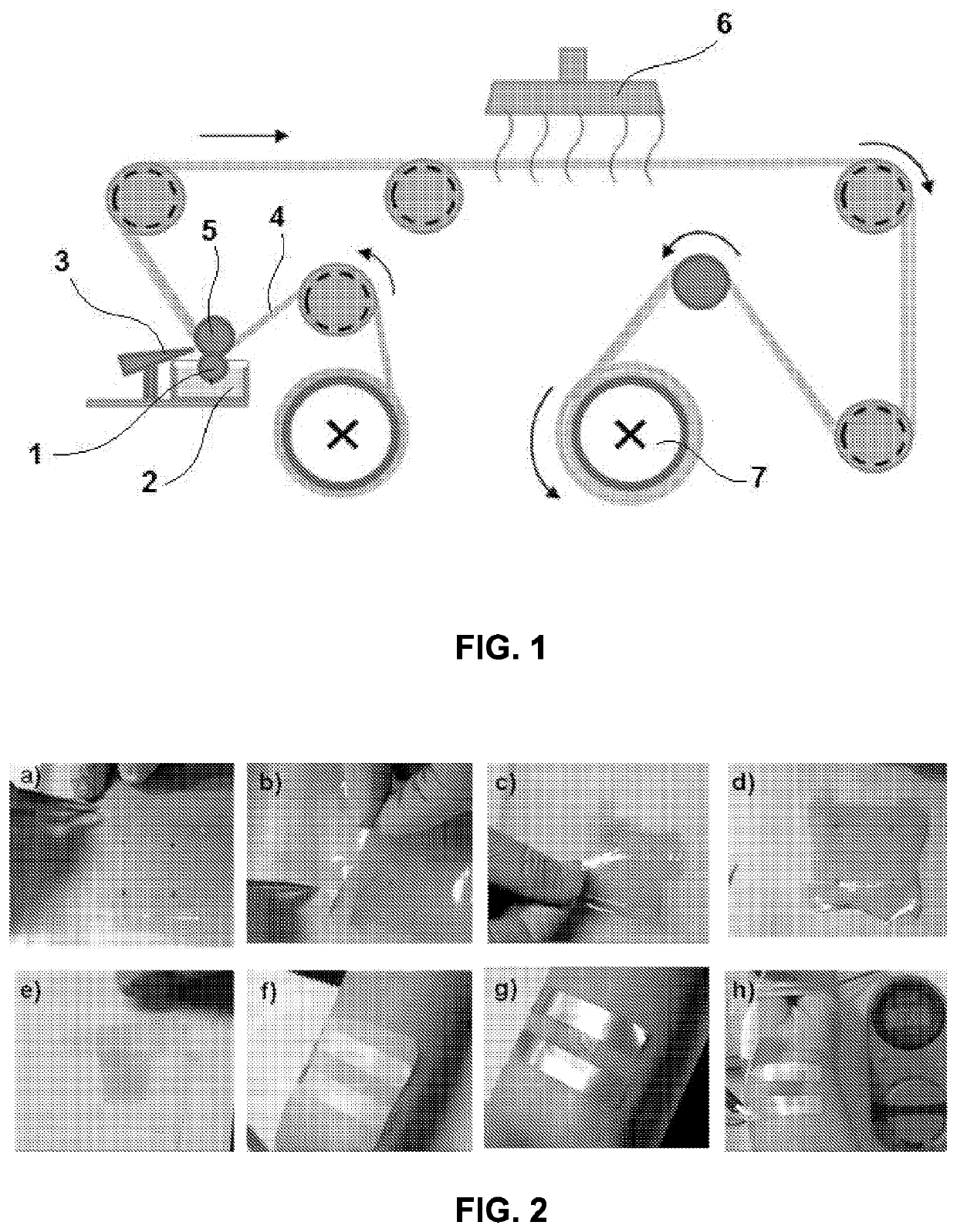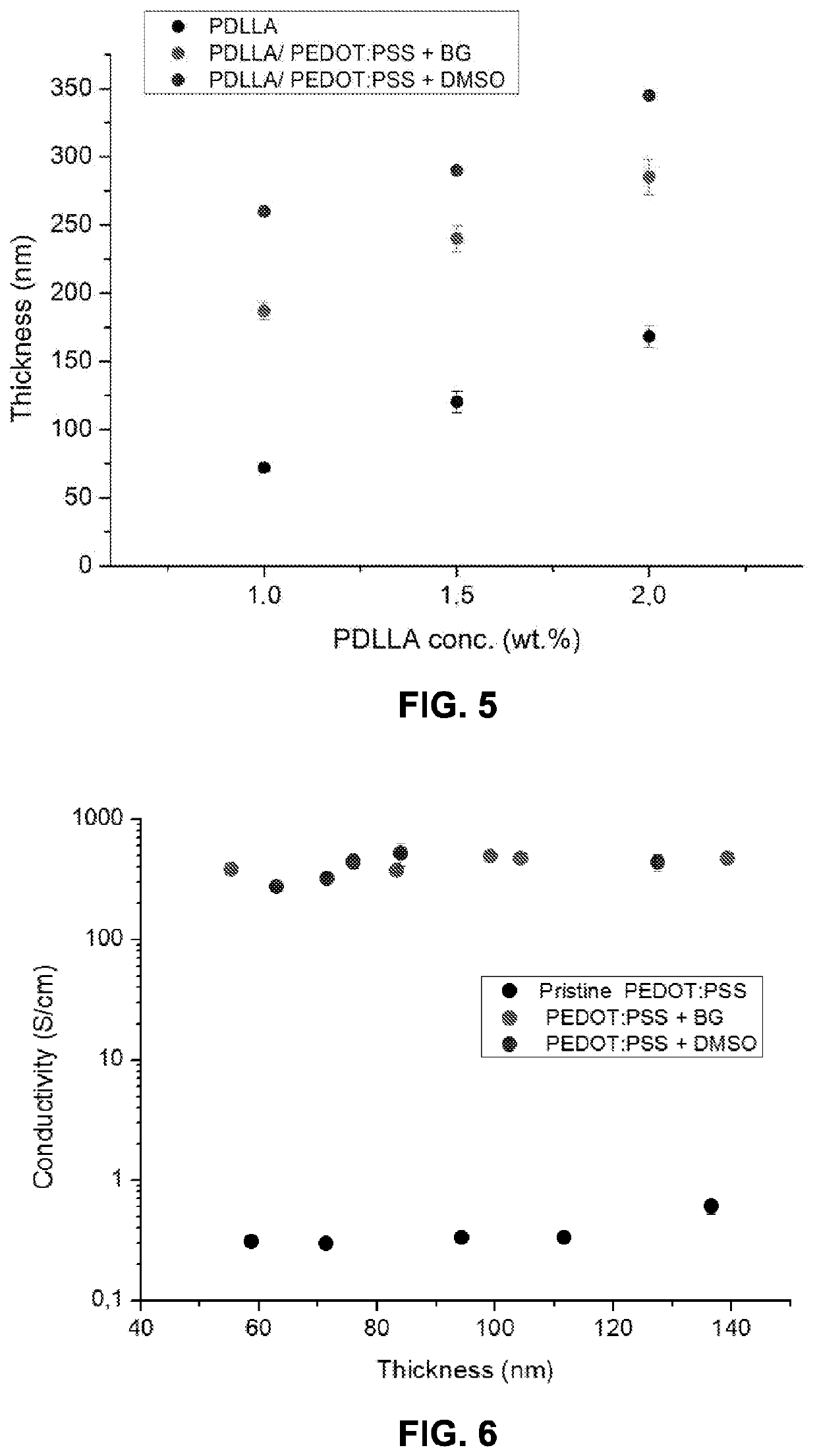Process for preparing free-standing films of conductive polymers
a technology of conductive polymers and free-standing films, which is applied in the field of free-standing films of conductive polymers, can solve the problems of difficult subsequent removal of the film, difficult dispersion and/or solubilisation, and difficult manipulation of the conductive thin film, etc., and achieves high electrical conductivity, simple and inexpensive, and high production efficiency.
- Summary
- Abstract
- Description
- Claims
- Application Information
AI Technical Summary
Benefits of technology
Problems solved by technology
Method used
Image
Examples
example 1
[0057]Preparation of a Monolayer Film of PEDOT:PSS, Pristine or Doped
[0058]A mono-layer film of PEDOT:PSS was prepared by using the R2R technique described above according to the following procedure that includes the formation of a sacrificial layer of cellulose acetate. A solution of cellulose acetate in acetone of concentration equal to 20 mg / ml was deposited on a film of polyethylene (in the following PET) with a thickness of 25 μm marketed by Toray under the trademark Lumirror® T60, by a R2R technique with a rotation speed of the gravure roll of 30 rpm and a speed of the line of 1.3 m / minute; then the deposited layer was dried at 80° C. with an air flow included in the R2R line. The film of PET coated with a layer of cellulose acetate is thus obtained in form of a roll, after its recovery by winding on a coil. An aqueous dispersion of PEDOT:PSS marketed under the trademark Clevios™ PH 1000 (H.C. Starck GmbH, Leverkusen, Germany), consisting of an aqueous dispersion of PEDOT / PSS ...
example 2
[0061]Preparation of Bi-Layer Films of PEDOT:PSS, Pristine or Doped, and PDLLA
[0062]A bi-layer film of PEDOT:PSS and PDLLA was prepared by using the R2R technique described above according to the following procedure. A solution of PDLLA (PM=330-600 kDa, marketed by Polysciences Inc.) in ethyl acetate was prepared having a concentration of 1% by weight of PDLLA with respect of the total weight of the solution. This solution was deposited on a polypropylene film (in the following PP) with a thickness of 40 μm, marketed under the trademark TORAYFAN® 2500H, by a R2R process with a rotation speed of the gravure roll of 25 rpm and with a speed of the line of 1.3 m / minute; then the layer deposited was dried with a flow of air at 80° C. The PP film coated with a layer of PDLLA was obtained in the form of a roll following winding on a coil. An aqueous dispersion of PEDOT:PSS marketed under the trademark Clevios™ PH 1000 (H.C. Starck GmbH, Leverkusen, Germany), consisting of an aqueous disper...
example 3
[0065]Characterization of the Film Thickness
[0066]The films prepared as described above have been subjected to measurements of the thickness by atomic-force microscopy with the equipment MFP-3D-BIO, Asylum Research Co., Santa Barbara, Calif., operating under a tapping mode. The measurements were carried out under air, at room temperature, on film samples collected on silicon wafers. For the mono-layered film of Example 1, they were collected on the silicon wafer after release in acetone; for the bi-layered film of Example 2, they were collected on the silicon wafer after release from the support layer taking the care of wetting with water the film surface in order to increase the adhesion with the wafer, then they were dried by using a compressed air gun. On the surface of each analysed film a scratch was made with a needle, then the surface was scanned with the Atomic Force Microscope (AFM) in a perpendicular direction with respect to the scratched edge in an area of approximately ...
PUM
| Property | Measurement | Unit |
|---|---|---|
| temperature | aaaaa | aaaaa |
| temperature | aaaaa | aaaaa |
| surface area | aaaaa | aaaaa |
Abstract
Description
Claims
Application Information
 Login to View More
Login to View More - R&D
- Intellectual Property
- Life Sciences
- Materials
- Tech Scout
- Unparalleled Data Quality
- Higher Quality Content
- 60% Fewer Hallucinations
Browse by: Latest US Patents, China's latest patents, Technical Efficacy Thesaurus, Application Domain, Technology Topic, Popular Technical Reports.
© 2025 PatSnap. All rights reserved.Legal|Privacy policy|Modern Slavery Act Transparency Statement|Sitemap|About US| Contact US: help@patsnap.com



